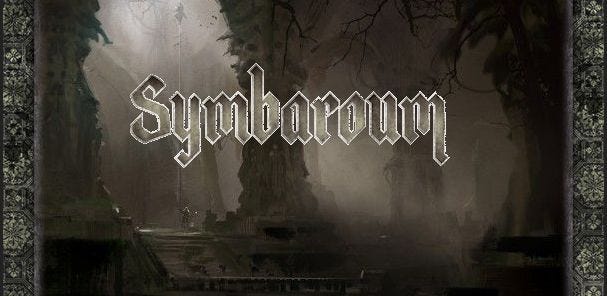
Over the past years there have been innumerable attempts at “building a better Dungeons & Dragons”. We’ve had several editions of D&D itself, from the horrendous 4th Edition to the current surprisingly good 5th Edition; we’ve had various attempts to recreate Old School D&D by the likes of Dungeon Crawl Classics and The Black Hack; and we’ve had lots of modernisations, most notable of which are probably 13th Age and Dungeon World.
Enter the Swedish contender: Symbaroum. As soon as you open this book, you feel it’s something special. It’s filled with haunting, evocative illustrations from the talented hand of Martin Bergström, and it’s beautifully laid out. The text itself is also extremely well-written (and kudos to the English translator, who has done a brilliant job here too). The whole thing screams that it’s a classy labour of love for these guys.

Theme-wise, the blurb on the back sets the story: “Twilight falls. Davokar darkens.” Yes, we’re once more in the land of the Grimdark RPG, and well, why not? If it’s done well, it’s a great premise. And done well it is. The whole of the first section of the book is about the world — actually it’s about a very small part of the world: a border town, a city, and a gigantic looming forest. Instead of going wide, they go deep, and it works. It’s all you really need for a good set of starting adventures: a base of operations, a place for some urban intrigue, and a big dark undiscovered area full of strange creatures and dungeons to plunder.

Race-wise, they take some unconventional choices: players can choose to be humans (civilised and barbarian), but they can also play ogres and goblins. They can’t play elves (who are effectively enemies in this game), and there are no dwarves and gnomes (so far), but they can play changelings, who are a sort-of half-elf done well.
Classes are always an issue in RPGs — they are a great way of giving players a hook to understand, but they are also very limiting. Symbaroum takes a middle ground by listing 3 basic archetypes: Warrior, Rogue, and Mystic, each with 5 Occupations. That’s simple enough to get going, but enough variation to allow players to really build out a unique character.
When it comes to combat and other mechanics, it’s easy to see the influence of Dungeon World and other Powered by the Apocalypse games. Only the players roll dice, the GM doesn’t; and weapons have fairly simple damage patterns, but modified by possessing certain qualities such as Small, Long, or Precise. Again, basically simple with unique characteristics. Symbaroum goes one step further however, but effectively doing the same for Player Characters. Instead of having traditional D&D STR, DEX etc. values, PCs are described by Attributes that each have a mechanical effect on the game, such as Cunning, Resolute, or Strong, and Abilities which work something like Feats in D&D, such as Berserker or Dominate.
Speaking of dice, all rolls (except damage) are on a single d20, which is a nod back to D&D, modified by the various Attributes and Abilities of both the PC and the enemy. I’m not generally a fan of the d20, but in this case they get it right again: it’s simple, fast and it works.

Now the tricky part: the magic system. This is where so many otherwise great RPGs fall down (Savage Worlds, I’m looking at you here). Symbaroum on the other hand, does this absolutely right. There’s a huge amount of variation of magic, and it’s really atmospheric, yet mechanically it’s still kept very simple. Magic also brings with it the possibility of Corruption, which provides the scary edge that a good magic system really needs. This is truly brilliant work.
The third part of the book is an excellent Game Master’s section. Some great advice given here. The Bestiary unfortunately has only a limited amount of monsters, but again they go deep rather than wide, and the enemies they do list are well described and have significant depth of character. After that there’s a list of good pre-made PCs, plus a shortish, but very well made adventure to get you started (which is also available as a free introductory download — get it!).
All in all, this is a stunning piece of work. It has all the sophistication of 13th Age, the mechanical beauty of Dungeon World, and the dark attractiveness of Warhammer Fantasy in a comprehensive and elegant game. Unfortunately it has a price tag to match: at 34.99 UK pounds this isn’t cheap. It is, however, a product of superlative quality, both in presentation and execution, that I think you’ll be playing for years to come; so you’ll be getting your money’s worth. Certainly the next time I run a tabletop fantasy game, this will be the book I’ll be reaching for.
